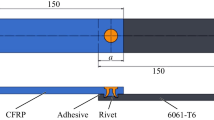Abstract
An experimental study was undertaken to determine the effect of corrosive environments on the strength of adhesive joints between pairs of glass-fiber-reinforced-plastic (GRP) plates and plates of GRP bonded to aluminum (Al). Two corrosive agents, each in three concentrations, were used: sulphuric acid (30, 50 and 60 percent) and sodium chloride (15, 20 and 25 percent). The results indicate a loss of strength with immersion time that levels off after a certain time. This loss of strength was more severe for the sulphuric acid than for sodium chloride. Ultrasonic attenuation of the adhesive joints was also monitored and it was found to increase with the immersion time, suggesting that the corrosion created inhomogenieties in the bond. The loss of strength and the increase in ultrasonic attenuation were both greater for greater concentrations of each of the corrosive agents.
Similar content being viewed by others
References
Bowditch, M.R. andStannard, K.J., “Adhesive Bonding of GRP,”Composites,13,298 (1982).
Rege, S.K. andLakkad, S.C., “Effect of Salt Water on Mechanical Properties of Fibre Reinforced Plastics,”Fibre Science and Technology,19,317 (1983).
Roberts, R.C., “Environmental Stress Cracking of GRP: Implications for Reinforced Plastics Process Equipments,”Composites,14,389 (1983).
Dewimille, B. andBunsell, A.R., “Accelerated Aging of Glass Fibre Reinforced Epoxy Resin in Water,”Composites,14,35 (1983).
Shen, C.H. andSpringer, G.S., “Environmental Effect on the Elastic Moduli of Composite Materials,”J. Comp. Mat.,11,250 (1977).
Prakash, R., “Nondestructive Testing of Composites,”Composites,11,217 (1980).
Kapoor, A. andPrakash, R., “Strength of Adhesive-Bonded Joints,”Proc. 6th Int. Conf. on Fracture, Fracture-84 (ICF-6), Pergamon Press, Oxford, 2649 (1986).
Cagle, C.V., Lee, H. andNeville, K., Handbook of Adhesive Bonding, McGraw-Hill Book. Co., New York (1973).
Author information
Authors and Affiliations
Rights and permissions
About this article
Cite this article
Prakash, R., Srivastava, V.K. & Gupta, G.S.R. Behavior of adhesive joints in corrosive environment. Experimental Mechanics 27, 346–351 (1987). https://doi.org/10.1007/BF02330305
Received:
Accepted:
Issue Date:
DOI: https://doi.org/10.1007/BF02330305




